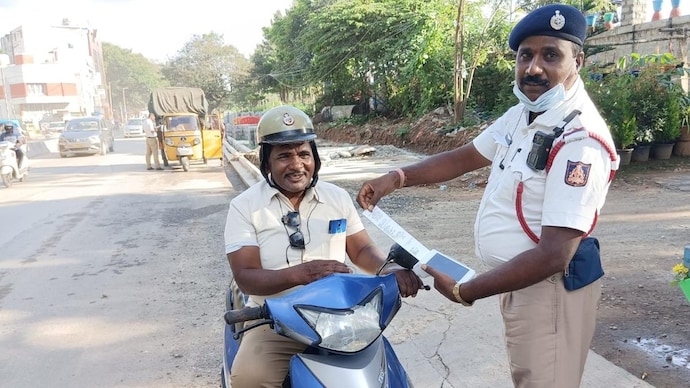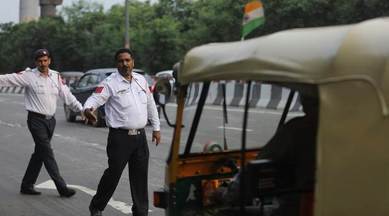The Bengaluru City Traffic Police (BTP) is preparing to introduce a unique initiative that will allow citizens to step into the shoes of traffic police personnel for a day. The programme, designed to foster deeper public participation in road governance, seeks to address the behavioural gap between commuters and enforcement authorities. Bengaluru, known both for its rapid growth and severe traffic congestion, stands at a crucial juncture where community intervention may prove transformative. This new model brings residents closer to the everyday stress of road management, while building a culture of shared responsibility in an ever-expanding metropolitan environment.
Officials say the initiative is rooted in growing concerns about widespread traffic violations, shrinking public patience, and strained mobility infrastructure. The city continues to witness lane indiscipline, reckless driving, and heavy pedestrian-vehicle conflict at peak hours. By enabling citizens to work alongside traffic personnel, the effort aims at bridging perception gaps that often fuel frustration or mistrust. Participants will be given basic instruction on safety, public messaging, and traffic control methods. The BTP hopes that the programme will strengthen mutual understanding, improve cooperation, and nurture admiration for the demanding work performed by officers every day.
This experiment in collaborative policing mirrors broader efforts to modernise traffic governance. Over the years, Bengaluru has launched initiatives such as automated violation tracking, junction sensors, road audits, and community-led campaigns. However, the city’s swelling population, increasing vehicle density, and uneven road infrastructure have outpaced many of these interventions. Authorities now view social partnership as a vital resource. By involving citizens firsthand, the programme goes beyond compliance, promoting empathy-driven adherence. Those who return from their one-day duty are expected to serve as ambassadors of safe driving within their neighbourhoods, multiplying the initiative’s long-term impact.
The programme will begin with an online registration system. Applicants will undergo an orientation module that includes an overview of traffic rules, emergency procedures, conduct guidelines, and effective civilian communication strategies. Selected participants will be posted at designated junctions under the direct supervision of trained traffic officers. They will not be empowered to levy fines or initiate punitive actions. Instead, their role will be advisory—helping guide pedestrian movement, directing vehicles during busy hours, and sharing awareness messages with commuters. Organisers believe this practical exposure increases community readiness to support police while ensuring operations remain legally compliant.
Authorities are assessing deployment models to ensure safety for volunteers. High-risk junctions will likely remain off-limits, while monitored intersections with controlled flows will serve as training grounds. Volunteers will be equipped with protective vests, identification badges, and basic safety gear. Women participants, in particular, will receive time-specific and location-sensitive postings to ensure comfort and security. The department is also exploring how to integrate student groups, workplace communities, and resident welfare associations, hoping to expand engagement while preserving operational discipline.

Participants are expected to witness, in real time, the psychological and physical pressure traffic personnel endure—long hours under intense sun, challenging public interactions, and the heavy burden of regulating complex flows. This contextual exposure may help change widespread assumptions that traffic officers merely issue penalties. Instead, it demonstrates that officers balance safety, persuasion, and immediate crisis handling simultaneously. The BTP anticipates that after participating, individuals will become stronger advocates for lane discipline, compliance with signals, safer pedestrian habits, and responsible driving behaviours.
The decision to launch this programme comes at a time when Bengaluru is attempting systemic mobility reforms. The city’s vehicular population recently crossed alarming multiples of its road capacity, aggravating commute times. Metro expansion, new bus fleets, and improved traffic signal integration have all offered relief, yet congestion intensity remains high. Therefore, behavioural governance—shaping how people drive—stands as an important complement. Citizens often blame infrastructure, enforcement, or planning, but disregard the part their own decisions play. This initiative re-centres accountability, showing how collective actions determine traffic outcomes.
COMMUNITY RESPONSIBILITY MAY RESHAPE TRAFFIC CULTURE
One of the programme’s strongest expected outcomes is empathy. In a city where road rage, impatience, and negligence are rising, authorities believe that temporarily working as a traffic official will create lived understanding. Participants can learn how minor indiscipline—blocking a zebra crossing or ignoring lane markers—quickly cascades into larger disruptions. This opportunity to analyse mobility from the officer’s perspective often highlights how individual choices influence group flow. Thus, the mission is not simply symbolic; it strives to introduce behavioural corrections that trickle into everyday movement patterns.
Many internal studies have shown that long-term traffic stability is closely linked to cultural compliance rather than aggressive enforcement. Cities that demonstrate smoother flows often reflect strong resident-led cooperation, where signalling respect, lane discipline, and pedestrian priority are internalised. Bengaluru’s pilot hopes to enable this evolution. If the programme’s alumni continue advocating rule-respectful conduct, workplace carpools and local communities could gradually shift their internal driving norms. Officials see this as a powerful organic mechanism for transport transformation—one that bypasses bureaucratic heaviness and reaches households directly.
The initiative carries immense educational promise for youth. College students, familiar with volunteering, can learn practical urban administration early. Understanding the constraints of enforcement prepares them to become informed citizens who recommend realistic solutions rather than idealistic proposals. Authorities may partner with universities to offer credit-linked participation, further incentivising involvement. Students could then use their experiences in academic projects, leading to data-driven insights on peak-hour patterns, pedestrian stress points, or junction-specific vulnerabilities. Such observations can shape future public infrastructure planning in constructive ways.

For many officers, the biggest challenge is persuasion—convincing drivers to follow rules without creating conflict. Citizens who participate may better appreciate the patience required to maintain calm in crowded settings. Additionally, officers often triple as negotiators, social workers, and emergency responders. Volunteers will observe responses to sudden medical emergencies, breakdowns, or street hazards. These moments may leave lasting impressions that soften rigid assumptions about enforcement and highlight the human emotional labour involved in the role.
REIMAGINING TRAFFIC ENFORCEMENT THROUGH PARTNERSHIPS
Though still in planning stages, the programme fuels discussion about future hybrid policing models. Traffic enforcement has traditionally been seen as government-centric, leaving little space for shared community roles. However, as cities grow denser, public participation may become critical. Bengaluru’s approach could inspire more structured frameworks—such as neighbourhood traffic custodians, periodic citizen-police patrols, or accredited local safety councils. Involving retired officers, transportation researchers, and civic volunteers could help preserve continuity and widen perspective on sustainable mobility actions.
Authorities are exploring ways to track the long-term influence of participants. Feedback surveys might track changes in volunteer driving habits or community influence. Encouraging regular alumni meetups could help build a knowledge network that reports emerging corridor issues or unsafe hotspots. This participatory information flow offers police important real-time insights that supplement traffic sensor data. Volunteer networks can also help authorities identify infrastructural blind spots—narrow pedestrian paths, malfunctioning signals, missing signage, or bottleneck-inducing road surface issues.
Business communities have also expressed interest in collaborating, especially in heavy-traffic industrial zones. Companies may volunteer their employees periodically to assist management drives. Industry-police partnerships could enable mobility planning around shift hours, emphasising staggered dispatch schedules or improved shuttle routing. Corporate participation may also improve workforce behaviour within premises, reducing congestion at bottleneck entry points during peak hours. Over time, transforming corporate commute culture could significantly influence mobility patterns around major employment clusters.
The psychological experience of wearing the uniform—albeit temporarily—may also instill a sense of public duty rarely developed through passive awareness campaigns. Even a single day of involvement can motivate citizens to comply with rules more consistently. Volunteers returning to their regular commute afterwards often carry newfound caution and responsibility. This emotional grounding can reshape household conversations about safety, encouraging seat belt usage, pedestrian courtesy, helmet compliance, and patience at intersections. Testimonies from previous community policing experiments in other contexts show that personal exposure remains one of the strongest behavioural catalysts.

School involvement may emerge as a longer-term possibility. While children cannot be stationed on roads, educational modules can simulate traffic management exercises. These workshops could help students understand safe mobility behaviours early. If reinforced with practical demonstrations, the learning becomes embedded across generations. When present youth mature into drivers, their decision-making reflects a public-safety-first mindset. This inter-generational ripple effect could prove crucial for a city whose long-term traffic challenges will continue evolving.
The initiative also serves as a reminder of the vulnerabilities police personnel face. Heat exposure, pollution, and limited rest drains physical resilience. Citizens working alongside them may develop respect for this burden, later supporting proposals for better working conditions, hydration facilities, shaded booths, and equipment upgrades. This shift in public sentiment is an important secondary benefit, as long-term force morale influences the quality of enforcement. Enhanced public empathy may help demand systemic wellness support for road personnel.
Authorities acknowledge that the project carries operational difficulties. Ensuring safety for untrained civilians requires meticulous planning. Designing deployment slots, coordinating supervision, and managing peak flows demands internal bandwidth. Yet BTP remains optimistic that the benefits outweigh early complications. If successful, the initiative may transition to a periodic fixture, possibly tied to awareness weeks or major commuting shifts. Gradual refinements can improve scalability, adapting to diverse neighbourhood intensities and road structures.
Follow: Karnataka Government
Also read: Home | Channel 6 Network – Latest News, Breaking Updates: Politics, Business, Tech & More

